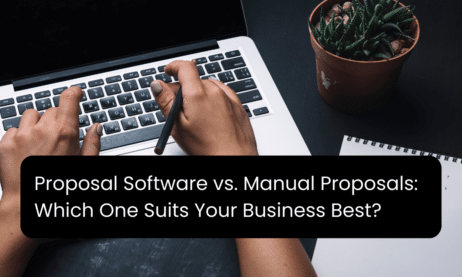Are you facing the dilemma of choosing between proposal software and sticking with traditional manual proposal writing methods? As a business owner, it’s necessary to weigh the advantages and disadvantages of each option. While manual proposals have been the go-to choice for decades, they often come with the drawbacks of being time-consuming and inefficient.
On the other hand, proposal software offers automation, better customization options, and integrated delivery methods. Your decision should hinge on factors such as your business needs, operational requirements, scalability, cost-effectiveness, and long-term goals.

Manual proposals have been a staple for businesses due to their simplicity. These proposals are typically created using tools like Microsoft Word or Excel, tailored to suit specific project requirements, and converted to PDF format for a professional touch. Some businesses also use Adobe Acrobat, which provides basic analytics insights and document protection.
However, manual proposals have inherent limitations, including the need to start from scratch for every proposal and repeatedly adjust templates to accommodate unique project scopes. This process can be both inefficient and time-consuming. Moreover, as businesses grow and demand more proposals, the inefficiencies of manual methods can become a burden.
While manual proposals offer the advantage of a personalized touch, their process could be more efficient and prone to inconsistencies. In contrast, automated proposal software solutions like Prospero provide templates, customization options, and integrated delivery mechanisms.
Pros of Manual Proposals:
- Personalization: Manual proposals allow for a high degree of personalization, enabling you to tailor your proposal to each client or project, demonstrating your dedication to their specific needs.
- Creativity: Manual proposals provide creative freedom, allowing you to design unique layouts, incorporate graphics, and experiment with fonts for a visually appealing and memorable presentation.
- Control: Creating proposals manually gives you complete control over every aspect of the document, facilitating easy changes and revisions as needed, ensuring accuracy and relevance.
- Cost-Effective: Initially, manual proposals can be cost-effective, especially for small businesses with limited budgets that may not afford specialized software.
Cons of Manual Proposals:
- Time-Consuming: Manual proposal creation can be time-intensive, requiring significant effort to gather information, format documents, and ensure consistency.
- Error-Prone: Manual proposals are more susceptible to human errors, such as typos and formatting mistakes, which can harm your professional image.
- Limited Collaboration: Collaborating with team members on manual proposals can be challenging, often involving the back-and-forth sharing of files, leading to version control issues.
Proposal Software
In recent years, proposal software has emerged as a valuable alternative to manual proposals by streamlining the creation process for businesses. Using this software has been shown to enhance efficiency, reduce manual workload, and save valuable time and resources that can be allocated to other operational needs. The templates and customization options offered by proposal software elevate the visual appeal of proposals, making them attractive to potential clients.

Moreover, the personalized delivery mechanisms provided by proposal software help businesses build stronger client relationships, while insightful analytics offer organizations the metrics and insights needed for effective decision-making. However, like all software, there are potential drawbacks to using proposal software that businesses must consider when evaluating their options.
The main disadvantage is the potential for higher costs associated with proposal software as an organization’s needs increase. Furthermore, adapting to new software can sometimes have a steep learning curve, which could impact short-term productivity.
Pros of Proposal Software:
- Efficiency: Proposal software streamlines the creation process, offering templates, automated formatting, and content libraries that save time and reduce the likelihood of errors.
- Collaboration: Most proposal software solutions offer collaboration features, enabling team members to work on the same document simultaneously enhancing efficiency and communication.
- Version Control: Proposal software ensures that everyone works with the most up-to-date version, reducing the risk of confusion and mistakes.
- Analytics: Many proposal software tools provide analytics that track recipient engagement, helping you understand which sections of your proposal are most compelling.
Cons of Proposal Software:
- Learning Curve: Implementing proposal software may require employees to learn and adapt to new tools and processes.
- Cost: While affordable software options exist, some advanced solutions can be costly, especially for small businesses with limited budgets.
- Potential for Generic Proposals: Over-reliance on templates and automation can sometimes lead to generic proposals that need a more personal touch for specific clients or projects.
While both methods have drawbacks, proposal software remains an exciting way for businesses to streamline and enhance their proposal creation process, especially as organizations scale up and demand increases. Therefore, businesses should evaluate both proposal software and manual options in the context of their organizational needs before deciding which option best fits their short- and long-term growth vision.
Factors to Consider When Choosing
The choice between proposal software and manual proposals hinges on several factors unique to each business. Therefore, evaluating operational needs, the scale of proposal generation, cost-effectiveness, and long-term growth vision is crucial.
- Scalability: As businesses expand, the demand for proposal generation increases, and the drawbacks of manual methods become more pronounced. Manual proposals consume considerable time and effort, resources that could be better utilized elsewhere. With its automated templates and customization options, proposal software accelerates the process while providing better visibility into performance. Proposal software is the better choice if your business has long-term growth plans.
- Volume of Proposal Generation: If your business generates many proposals with similar services or products, proposal software can be a game-changer. It saves time, offers insightful analytics, and reduces human error. In contrast, if your business produces only a few proposals each year, manual proposals may suffice, albeit at the cost of more time and effort.
- Operational Needs: When considering software, assess the features essential for your business. Proposal software offers real-time alerts, proposal behavior tracking, statistics for decision-making, digital acceptance, e-signatures, and proposal access control. Select software that aligns with your organizational needs. On the other hand, manual proposals are more straightforward to customize according to specific client requirements. Choose a method that aligns with your business model.
- Cost-to-Benefit Ratio: Another factor to consider is the cost-to-benefit ratio. Proposal software requires an initial investment that varies depending on the software, features required, and chosen billing cycle. Manual proposals are more cost-effective initially, but proposal software offers more advantages. Making it a worthwhile investment for businesses with long-term growth visions.
- Long-Term Growth Vision: The choice between proposal software and manual proposals should align with your long-term growth vision. The goal is to increase conversions by crafting compelling proposals that foster profitable client relationships. Proposal software automates the process, provides insights into proposal performance, reduces human error, and improves efficiency. Meanwhile, manual proposals struggle with inefficiencies due to the time and effort required, hindering long-term growth.
In summary, choosing between proposal software and manual proposals depends significantly on understanding your business’s needs, considering scalability, volume of proposal generation, operational requirements, cost-effectiveness, and long-term growth vision. Therefore, evaluate both methods and select the one that serves your business best.
Proposal Software to Explore
If you’re considering choosing a proposal software for your business, you’re in luck, as a wide variety of software options are available today. One popular choice is Prospero; its many helpful features make it great for creating impressive proposals. It has an extensive library of ready-made content, so you don’t have to start from scratch.

There are more than 100 templates to pick from, making it easy to customize your proposals. Other perks include:
Tracking- Prospero helps you see how it’s doing once you send out your proposal. You can check if it’s been seen, how many times, and for how long.
E-signature- Prospero makes it easy for your client to append signatures. Your client can sign on any device, and they can draw, type, or upload their signature. Managing Prospero on the back end is simple, too. You can control who sees what, which makes things organized and secure.

Integration- Prospero integrates well with other tools like Zapier, Poptin, Intuit QuickBooks, Slack, Xero and Stripe.
More than 2,000 businesses also trust Prospero in 57 countries, so you can rest assured that it’s the best software for you to explore.
If you’re not sure about Prospero, you can try it out for free for 14 days. This way, you can see if it’s right for you. Just sign up here and see how Prospero can make your proposals better.
Final Thoughts
In conclusion, the decision between proposal software and manual proposals should be based on your business’s unique needs, considering scalability, volume of proposal generation, operational requirements, cost-effectiveness, and long-term growth vision. While manual proposals offer simplicity and personalization, proposal software enhances efficiency and proficiency, reducing manual workload and human error.
Both methods have advantages and disadvantages, but the ultimate goal is to increase conversions by crafting compelling proposals. Choose the option that aligns best with your business model and sets the stage for profitable client relationships.




